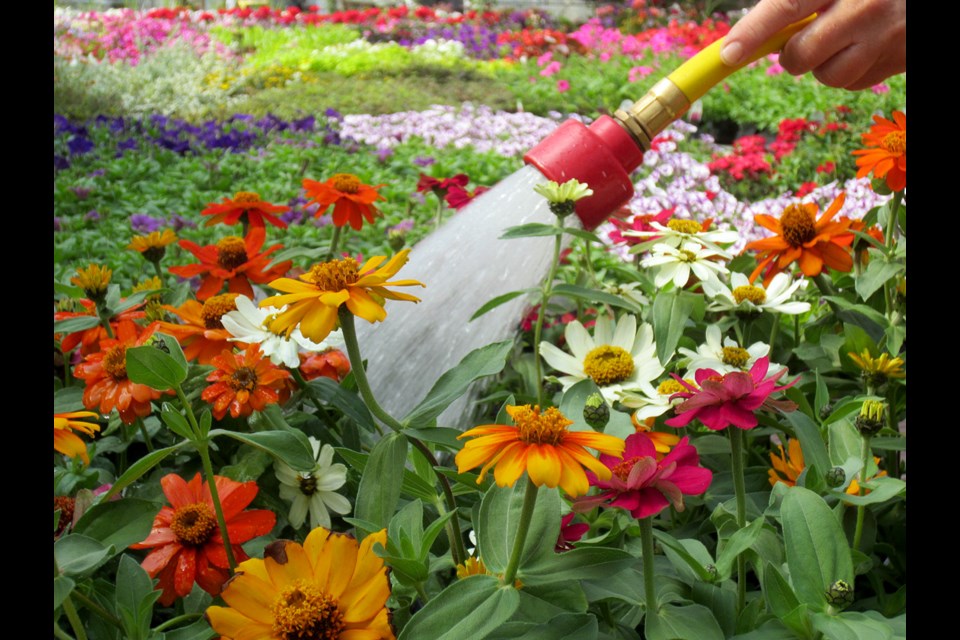After another month of chilly, damp weather we’re about to experience some super-hot temperatures.
It looks as though the weather will be great for swimming pools and barbecues but, as pleasant as this may be, early hot weather can be tough on our plants.
Sudden heat and soaring temperatures create a demand for moisture that cannot always be met on short notice by the root systems of many plants.
The result is burnt blossoms, damaged foliage and hard, stunted growth.
Fortunately, there are ways of minimizing the problems caused by an unexpected hot spell.
The most immediate relief for plants is a thorough, deep watering.
It is best to do this early in the morning when the plants will make the greatest use of the water. Watering in the evening wastes water because plants simply transpire valuable moisture away.
The other huge issue is where to water. Soaker hoses around the perimeter of all trees and shrubs is sometimes the most effective way to water. When you do water, saturate the soil deeply where the roots are, to keep them going downward instead of upward in their efforts to capture what little moisture there is.
The next most important task is to mulch as many of your trees and shrubs as possible with suitable material.
You should be looking for something that is a good insulator, can eventually be worked into the soil, and has an attractive appearance. Garden compost is fine if it is well broken down, but its appearance is not always the best, especially when it dries out.
Manures are also suitable but remember that they are on the slightly alkaline side of the pH scale and can cause problems with your acid loving plants like rhododendrons, azaleas and camellias.
If you do use manures, be sure they have been composted for at least six months.
Grass clippings are also good but only in the short run; once they dry out they tend to look rather shabby. My preferred choice is always fir or hemlock bark mulch; it’s a wonderful insulator, it looks great, and it makes a fine soil amendment. A covering at least three to four inches deep all around your plant material will prevent a great deal of stress, especially for shallow-rooted plants like rhodos.
Hedging cedars also have very shallow roots which will dry out quickly, even with just a few days of intense heat, so use soaker hoses all along the base to alleviate this problem.
Dig a couple of test holes after watering to make sure the water is penetrating all the way down to the roots, because it does take time to saturate the soil adequately.
A thorough watering is the most import stress-relieving factor for all plants under the eaves of your home. Heat reflected off buildings can be a real challenge for plants so do not neglect either sunny or shady areas immediately around your homes and outbuildings. Here, too, I find soaker hoses and drip systems are, by far, the most efficient and thorough methods of watering, not to mention some of the easiest.
Try to get into the habit of watering all your veggies, annuals and perennial beds and containers very thoroughly, making sure the roots and soil mass are moist deep down, not just on the surface.
Water less frequently, but really soak the soil when you do.
Well established lawn grasses are very resourceful. Here too, it is far better to water less frequently, but important to water deeply so the roots are heading down into the soil to find moisture, not creating a mat close to the surface where they will dry out that much faster.
Recently laid turf and newly seeded lawns, of course, have different requirements; they must have consistent moisture until their roots are well enough established to withstand drought.
For all your plants, proper soil preparation is really the key. When you are planting trees and shrubs, make sure the planting hole is at least twice as wide and deep as the root ball and contains lots of organic matter to create an environment where plants can become well established quickly and become self-sustaining over the long haul. Plants need soil that drains well, yet still has the ability to retain moisture during long dry periods.
Try to move away from overhead sprinklers and towards root soaking systems. They are much better at delivering water directly to the plants where it needs to be, instead of soaking everything, so you will ultimately conserve water.
Don’t be fooled by wilted leaves and assume a plant is dry. Often heat stress causes wilt, and the plant will bounce back in the cooler evening temperatures. Over-watering can cause root rot, something that happens all too frequently.
With proper soil preparation, mulching and a thoughtful watering strategy, all our garden plants should be able to withstand both heat and water restrictions. You might also consider collecting rainwater in barrels when it rains; it’s great to have a back-up supply when those water restrictions come into effect.
To conserve water, we all need to be more aware of the way we use water around our homes and in our gardens. Now is a good time to put our plans in place.





